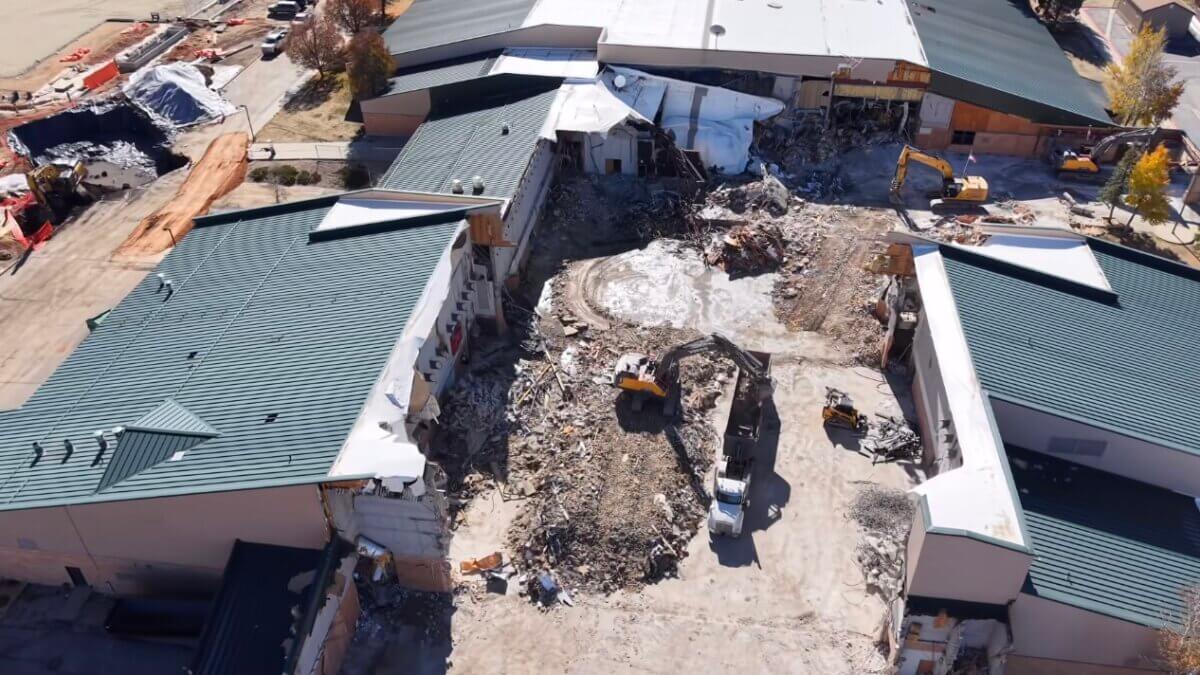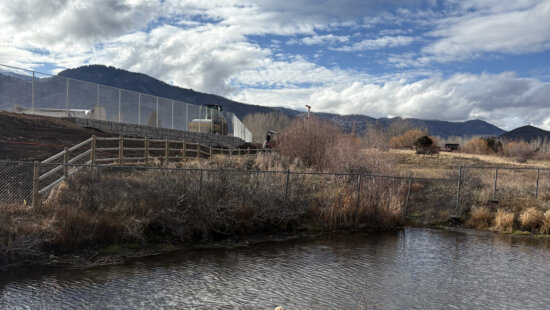Environment
Park City School District receives non compliance notice after demolition with asbestos still present

Demolition underway at Treasure Mountain Junior High School on November 10, 2025. Photo: Trip Marshall / PCHS Aviation
PARK CITY, Utah — Utah environmental regulators issued a compliance advisory to Park City School District after inspectors found the district failed to properly manage asbestos during the demolition at Treasure Mountain Middle School.
TownLift obtained the advisory from a whistleblower, who also provided documents outlining other potential environmental violations now under review.
The Utah Division of Air Quality cited the district for failing to properly manage asbestos during demolition at the school, located at 2530 Kearns Boulevard. The citation came after DAQ responded to a complaint that an architect had approved demolition despite 4% asbestos remaining in surfacing material, according to information obtained by TownLift. Strict regulations apply to materials with greater than 1% asbestos content.
DAQ Inspector Jared James observed the violations during an Oct. 22 inspection and caught workers in the process of illegal demolition, according to the compliance advisory.
The district violated the federal Asbestos Hazard Emergency Response Act by failing to update its asbestos management plan to reflect current operations and maintenance activities. Federal regulations require all asbestos-containing materials to be removed before demolition can proceed.
The school district had 10 business days from receiving the notice to respond with either evidence the deficiencies are not violations or a schedule for correcting them. Their response, filed on November 13 by the district’s asbestos consultant, Cripple Creek Consulting & Environmental, outlines testing, survey processes, and the corrective actions taken.
A spokesperson from the DAQ confirmed the department had knowledge of the presence of asbestos at Treasure Mountain Junior High and verified the compliance advisory was sent.
Park City School District’s Public Information Officer Colton Elliott said in a statement, the district takes environmental compliance seriously and emphasized that a certified environmental specialist has been onsite daily throughout demolition.
“When asbestos-containing material was identified in a specific area of the building, demolition in that area was immediately paused. Licensed abatement professionals then completed the regulated removal process in full compliance with state oversight,” the statement read, however the Cripple Creek letter states the presence of asbestos was recorded before demolition took place.
The district also said no workers, students or community members were ever at risk because the abatement occurred in controlled zones with continuous air monitoring.
Officials added that demolition has continued in areas cleared of asbestos, that the asbestos consultant has submitted a formal response to the Utah Division of Air Quality, and that the district has not been issued any fines or penalties.
The DAQ accepted a revised project design for the school on Oct. 29, one week after the inspection, according to documents reviewed by TownLift.
A work plan submitted to DAQ, Fresh Air Environmental Solutions, Inc. described asbestos-containing materials discovered in the ceilings of the boys’ and girls’ locker rooms. Since demolition was already underway, the letter stated, the company requested DAQ waive the 10-day waiting period and outlined their cleanup plan.
In another alternative work practice request form, Fresh Air Environmental Solutions, Inc. stated that a “delay of work would cause financial hardship for the school as well as the contractor.”
It went on to read, “There is also a concern for safety risks as the work is adjacent to a school” in part of the form that asked why it was not feasible to comply with state and federal asbestos rules and regulations.
A copy of the advisory was also sent to Summit County Health Department.
A site with a complicated environmental history
The Treasure Mountain campus sits on a property regulated under the federal Comprehensive Environmental Response, Compensation, and Liability Act (CERCLA), commonly known as Superfund. Though not a full Superfund site, Treasure Mountain is subject to a CERCLA agreement and environmental lien stemming from historic mining contamination.
Because federal funds were used to remediate mining waste on the property, the Environmental Protection Agency retains oversight authority. That means environmental requirements at Treasure Mountain are more stringent than those governing typical construction sites in Park City. Environmental professionals involved in the demolition have previously described the CERCLA constraints as giving EPA and state regulators enhanced power to control cleanup methods, waste handling, and soil disturbance.
The school campus underwent major remediation more than a decade ago after highly contaminated mine tailings and toxic soil were discovered beneath portions of the grounds. Much of that material—containing elevated levels of lead and arsenic—was excavated and removed under EPA supervision. Any new construction or demolition on the site must comply with the existing cleanup agreement and cannot disturb capped or remediated areas without regulatory approval.
In November 2022, McPolin Elementary, located adjacent to Treasure’s campus, had to relocate the school’s playground due to dust from contaminated surface soil which was removed and piled behind Treasure Mountain Junior High.
Why asbestos matters
Asbestos was widely used in building materials for insulation, flooring, siding, fireproofing and ceiling texture throughout much of the 20th century. When those materials are cut, broken or disturbed during renovation or demolition, microscopic fibers can become airborne and remain suspended for hours.
Inhalation of asbestos fibers is linked to serious, often fatal illnesses, including mesothelioma, lung cancer and asbestosis. Federal law requires schools to maintain detailed asbestos management plans, perform routine inspections, and remove asbestos-containing materials under strictly controlled conditions.
Editor’s note: This story was updated with additional information regarding the DAQ work plan.




















